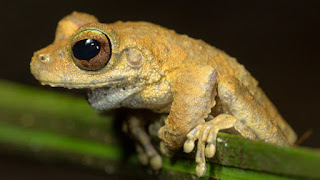Photos: Meet the surprisingly diverse day geckos of Sri Lanka - Mongabay.com
- The number of geckos in the genus Cnemaspis has grown rapidly as new species are described, with Sri Lanka the epicenter of new discoveries.
- The island is today home to 33 known species of day geckos, none of them occurring anywhere else on Earth, and it's possible there may be 44 by 2020, a leading herpetologist says.
- As new species continue to emerge, researchers are calling for urgent conservation efforts and ecological studies to ensure that the remaining microhabitats are not lost and that these unique species are not driven toward extinction.
COLOMBO — "For a small island, there is amazing species diversity here," says Sameera Suranjan Karunarathna, a leading herpetologist in Sri Lanka.
Diversity abounds among the island's reptiles, many of them found nowhere else on Earth, and in particular among a group of lizards.
There are 153 known species in the genus Cnemaspis, a group known as day geckos because they're active during the daytime. Sri Lanka is home to 33 species of day geckos, or a fifth of the global total — and those are only the ones that have been formally described so far.
In the last 10 years, there have been an increasing number of new Cnemaspis species identified across the globe, and the pace of discovery in Sri Lanka has been even more vigorous: 90 percent of the known species on the island were described in the past two decades.
"By the end of 2004, there were only four Cnemaspis species but now there's 33," says Karunarathna, who was involved in the description of nine of those species this year alone. Sri Lanka's known endemic day geckos are likely to reach around 44 by the end of 2020, he adds.
The abundance of discoveries spells both good news and bad, says Mendis Wickramasinghe, a pioneering herpetologist known as "Sri Lanka's Darwin" for having introduced more than a hundred species new to science.
"The recent species discoveries indicate several things: one is Sri Lanka's rich biodiversity. Also, these species emerge from threatened habitats, and small changes to microhabitats can make their survival difficult and even drive them to extinction," he says.
This is especially true of day geckos, which are typically extremely sensitive creatures, preferring specific microhabitats, sometimes as small as 100 square meters (1,080 square feet), in a tree or a cave. These are often habitats with minimum human disturbance.
Day geckos are also indicator species — harbingers of the health of their habitat.
"Indicator species are very special to the world of science," Wickramasinghe says. "These discoveries should also inspire further studies on conservation management."
Karunarathna agrees, adding that the ongoing process of describing new species needs to be supplemented with ecological studies of their habitats.
Twenty-six of the 33 endemic day geckos are considered critically endangered. While Mongabay has reported on several of the newer discoveries, for the first time here we present all 33 of Sri Lanka's Cnemaspis species.
Cnemaspis alwisi (2007)
The Alwis's day gecko was described in 2007 by Wickramasinghe and his colleague, Amith Munindradasa. They named it after Lyn De Alwis, a legendary Sri Lankan conservationist, for his efforts to push research in wildlife conservation and natural resources. The species is found primarily among the boulders of the Dolukanda area in the district of Kurunegala, in Sri Lanka's northwest, as well as in Ritigala and Maragala mountains and the Nilgala area.
Its coloration follows that of the lichens that abound on the wet boulders found in the area, offering a useful camouflage to easily blend into the environment.

Cnemaspis amith (2007)
This is another species described in 2007, and was named after the late Amith Munindradasa. A combination of characteristics distinguishes it from similar species in India. It's not known to occur anywhere outside where it was first described.
Cnemaspis anslemi (2019)
One of the more recent additions to the genus, this species was described this year and named in honor of the prolific Sri Lankan herpetologist Anslem de Silva — "the father of modern-day herpetology in Sri Lanka." It's a diminutive species found only in the lush green canopied region of Udamaliboda, in the northwestern foothills of Samanalawewa Nature Reserve.
Cnemaspis butewai (2019)
Another species described this year, Cnemaspis butewai was named in honor of Butewe Rate Rala, a hero of the Sri Lankan uprising against British colonial rule during the the Uwa-Wellassa Rebellion of 1817-1818. This critically endangered species, restricted just to six known locations, was discovered from the Bambarabotuwa forest reserve, at an elevation of 380 to 850 meters (1,250 to 2,800 feet) above sea level. It dwells among the rock outcrops and granite caves of the forest canopied areas.

Cnemaspis gemunu (2007)
Cnemaspis gemunu was described in 2007, one of countless new reptile species that Anslem de Silva helped introduce to the world. It was found in the central district of Nuwara Eliya and named after the warrior king Dutugamunu, who is credited with uniting the island and ruled Sri Lanka from 161-137 B.C.E. The species is typically found in the botanical gardens of Hakgala, located at an elevation of about 1,660 meters (5,450 feet) above sea level.

Cnemaspis godagedarai (2019)
Another new species from the class of 2019, and introduced by Suranjan Karunarathna and others, Cnemaspis godagedarai comes from Sri Lanka's only rainforest, Sinharaja. It was discovered in a mountainous area between 700 and 800 meters (2,300 and 2,600 feet) above sea level and isolated from the rest of the forest canopy by streams, making it "point endemic," or restricted to a very small area. The critically endangered gecko was named after Godagedara Rate Adikaram, another of the fighters in the uprising against the British colonial government.

Cnemaspis gotaimbarai (2019)
Cnemaspis gotaimbarai is named after one of the legendary Ten Giant Warriors who served the ancient Sinhala king Dutugamunu. It's restricted to rock outcrops and granite caves in forested areas and is considered critically endangered due to low numbers and density.
The species is one of a group of six described by Karunarathna this year (along with C. butewai, C. nandimithrai, C. kohukumburai, C. hitihami and C. kivulegedarai) that sparked a political firestorm. Nationalist politicians and religious figures criticized the researchers for what they said was disrespect for the historical figures by naming them after lowly geckos. The scientific community has stood firm in support of Karunarathna and his colleagues, pointing out that being named after a new species is considered a mark of honor.

Cnemaspis hitihami (2019)
Cnemaspis hitihami was named after Meegahapitiye Walawwe Hitihami Mudiyanselage Rate Rala, another hero of the Uwa-Wellassa Rebellion. It was discovered from a granite cave in the Maragalakanda area in the district of Monaragala. Individuals are restricted to rock outcrops and granite caves in forested areas. Given the low numbers and density, with the species being recorded only in seven location, this day gecko is considered critically endangered.

Cnemaspis ingerorum (2019)
Another species described this year, Cnemaspis ingerorum was described from the dry zone of Hambantota in Sri Lanka's deep south, at an elevation of 100 meters (330 feet) above sea level. It's generally observed on rock surfaces but close to the ground or in the leaf litter layer inside rock caves. It was named after Robert Frederick Inger and Tan Fui Lian Inger of the Field Museum of Natural History for their contributions in the field of herpetology and support for biological exploration in Sri Lanka.
Cnemaspis kallima (2007)
Discovered in 2007 at a single site in the Gammaduwa tea estate in the lush central district of Matale, Cnemaspis kallima is only known from its original description. The unique appearance of this day gecko earned it its name, Kallima, derived from the Greek kallos for beauty.
Cnemaspis kandambyi (2017)
This doe-eyed day gecko was discovered in 2017 from the Meemure region of the Knuckles Range in the island's central highlands. It is named after Dharma Sri Kandamby, a former curator of the vertebrate section of the National Museum of Sri Lanka, for his contributions to the advancement of herpetology.
Cnemaspis kandiana (1852)
The Kandyan day gecko or Kandyan rock gecko was one of the first to be described from Sri Lanka, in 1852. It lives in the mountains of Kandy, in the forest-canopied central region of Sri Lanka.

Cnemaspis kivulegedarai (2019)
Cnemaspis kivulegedarai is named after Kivulegedara Mohottala, a hero of the Uwa-Wellassa Rebellion, and one of the six newly described species this year whose naming has attracted controversy. Discovered from the Keerthibandarapura area in Walapone in the central district of Nuwara Eliya, this gecko dwells in rock outcrops and granite caves in forested areas. It is considered critically endangered.



Comments
Post a Comment